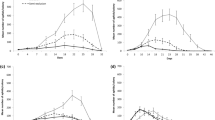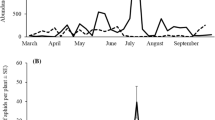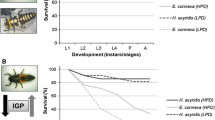Abstract
In the present study, we investigated the natural control of aphids by predators in wheat fields in a low (L) and high-input cropping region (H) of Germany during a 10-year period. Data for the statistical analyses were obtained from weekly after the start of aphid emergence. The mean annual aphid indices, calculated as the sum of Sitobion avenae (Fabr.), Rhopalosiphum padi (L.), Metopolophium dirhodum (Walk.)(Homoptera: Aphididae), were 30.4 and 81.5 × 10³ aphid days per m², for L and H, respectively. Nine predator fractions were analysed: Coccinella septempunctata L., adults (1) and larvae (2), Propylea quatuordecimpunctata (L.) (Coleoptera: Coccinellidae) adults (3) and larvae (4), syrphid larvae (mostly Episyrphus balteatus [De Geer] (Diptera: Syrphidae)) (5), Chrysoperla carnea Steph. (Neuroptera: Chrysopidae) larvae (6), and adult carabids (7), staphylinids (8) and spiders (9). The two sites were comparable in terms of the mean size of the overall predator community, expressed in predator units (PU): 4.9 PU/m² (L) vs. 5.4 PU/m² (H). Most predator fractions responded numerically to increasing aphid densities. The numerical response was strongest in syrphid larvae, scarcely detectable in adult coccinellids, and virtually non-existent in epigeic arthropods. Multiple regression models revealed indirect relationships between the weekly overall predator community densities (PU/m²) and individual predator fractions (individuals/m²) and absolute rates of aphid density increase (individuals/m²) one or two weeks after baseline. A site-independent reduction of the aphid density increase to nil (y = 0) was observed at 3.9 to 4.2 PU/m². Consequently, the 2.7 times higher aphid density at H cannot be attributed to the presence of fewer predators or lower effects of the overall predator community or of any individual predator fraction.


Similar content being viewed by others
References
Chambers RJ, Adams THL (1986) Quantification of the impact of hoverflies (Diptera: Syrphidae) on cereal aphids in winter wheat: an analysis of field populations. J Appl Ecol 23:895–904
Chen Y, Giles KL, Payton ME, Greenstone MH (2000) Identifying key cereal aphid predators by molecular gut analysis. Molecular Ecol 9:1887–1898
Dixon AFG (2000) Insect predator-prey dynamics: ladybird beetles and biological control. Cambridge University Press, Cambridge
Dixon AFG, Hemptinne JL, Kindlmann P (1997) Effectiveness of ladybirds as biological control agents: patterns and processes. Entomophaga 42:71–83
Duffield SJ, Bryson RJ, Young JEB, Sylvester-Bradley R, Scott RK (1997) The influence of nitrogen fertiliser on the population development of the cereal aphids Sitobion avenae (F.) and Metopolophium dirhodum (Wlk.) on field grown winter wheat. Ann Appl Biol 130:13–26
Ekbom BS, Wiktelius S, Chiverton PA (1992) Can polyphagous predators control the bird cherry-oat aphid (Rhopalosiphum padi) in spring cereals? A simulation study. Ent Exp Appl 65:215–223
Elliott NC, Kieckhefer RW, Beck DA (2000) Adult coccinellid activity and predation on aphids in spring cereals. Biol Control 17:218–226
Freier B, Triltsch H (1996) Climate chamber experiments and computer simulations on the influence of increasing temperature on wheat – aphid – predator interactions. In: Edis D, Hull MR, Cobb AH, Sanders-Mill GE (eds) Implications of ‘Global Environmental Change’ for Crops in Europe. Aspects Appl. Biol 45:293–298
Freier B, Triltsch H, Möwes M, Rappaport V (1998) Predator units – an approach to evaluate coccinellids within the aphid predator community. IOBC wprs Bull 21(9):103–111
Freier B, Triltsch H, Möwes M, Gosselke U, Adisu B, Lee SG (2003) Different effects of aphid antagonists in wheat in two different landscapes and the consequences for integrated pest management – results of 10-year field studies. IOBC wprs Bull 26(4):53–58
Freier B, Triltsch H (2005) The potential of Coccinella septempunctata L. and Propylea quatuordecimpunctata (L.) in natural control of aphids in wheat – 10-year field studies and computer simulations. Proc Symp Biol Control Aphids Coccids Tsuruoka Jpn, September 25–29:70–75
Gosselke U., Triltsch H, Roßberg D, Freier B (2001) GETLAUS01 – the latest version of a model for simulating aphid population dynamics in dependence on antagonists in wheat. Ecol Modell 145:143–157
Harwood JD, Sunderland KD, Symondson WOC (2005) Monoclonal antibodies reveal the potential of the tetragnathid spider Pachygnatha degeeri (Araneae: Tetragnathidae) as an aphid predator. Bull Ent Res 95:161–167
Hasken KH, Poehling HM (1994) Some effects of low input agriculture on cereal aphids and aphid specific predators in winter wheat. Bull IOBC/WPRS 17:137–147
Hemptinne J-L, Dixon AFG, Coffin J (1992) Attack strategy of ladybird beetles (Coccinellidae): factors shaping their numerical response. Oecologia 90:238–245
Holland JM (1998) The effectiveness of exclusion barriers for polyphagous predatory arthropods in wheat. Bull Ent Res 88:305–310
Holland JM, Thomas SR (1997) Quantifying the impact of polyphagous invertebrate predators in controlling cereal aphids and in preventing wheat yield and quality reductions. Ann Appl Biol 131:375–397
Holland JM, Cook SK, Drysdale AD, Hewitt MV, Spink J, Turley DB (1998) The impact on non-target arthropods of integrated compared to conventional farming: results from the LINK integrated farming systems project. Proceedings British Crop Protection Conference, Pests Diseases, November 16–19, 1998 (2), Brighton pp 625–630
Kindlmann P, Dixon AFG (1999) Generation time ratios – determinants of prey abundance in insect predator-prey interactions. Biol Control 16:133–138
Kindlmann P, Dixon AFG (2001) When and why top-down regulation fails in arthropod predator-prey systems. Basic Appl Ecol 2:333–340
Kühne S, Enzian S, Jüttersonke B, Freier B, Forster R, Rothert H (2000) Structure and function of field margins in Germany and their consideration in pesticide registration with regard to conservation of non-target arthropods (in German) Mitt BBA 378:1–128
Lee JH, Elliott NC, Kindler SD, French BW, Walker CB, Eikenbary RD (2005) Natural enemy impact on the Russian wheat aphid in southeastern Colorado. Environ Ent 34:115–123
Madsen M, Terkildsen S, Toft W (2004) Microcosm studies on control of aphids by generalist arthropod predators: effects of alternative prey. BioControl 49:483–504
Meier U (1997) Growth stages of mono- and dicotyledonous plants. BBCH-Monograph. Blackwell, Berlin, Vienna
Moreby SJ, Aebischer NJ, Southway SE (1994) A comparison of the flora and arthropod fauna of organically and conventionally grown winter wheat in southern England. Ann Appl Biol 125:13–27
Nienstedt KM, Poehling HM (2004) Invertebrate predation of 15N-marked prey in semi-field wheat enclosures. Ent Exp Appl 112:191–200
Plantegenest M, Pierre JS, Dedryver CA, Kindlmann P (2001) Assessment of the relative impact of different natural enemies on population dynamics of the grain aphid Sitobion avenae in the field. Ecol Ent 26:404–410
Poehling HM, Borgemeister C (1989) Abundance of coccinellids and syrphids in relation to cereal aphid density in winter wheat fields in northern Germany. Bull IOBC wprs 12(1):99–107
Rautapää J (1966) The effect of the English grain aphid Macrosiphum avenae (F.) (Hom., Aphididae) on the yield and quality of wheat. Ann Agric Fenn 5:334–341
Rossberg D, Gutsche V, Enzian S, Wick M (2002) Neptun 2000 – survey into application of chemical pesticides in agricultural practice in Germany (in German) Berichte BBA 98:1–27
Schellhorn NA, Andow DA (2005) Response of coccinellids to their aphid prey at different spatial scales. Popul Ecol 47:71–76
Skirvin DJ, Perry JN, Harrington R (1997) A model describing the population dynamics of Sitobion avenae and Coccinella septempunctata. Ecol Modell 96:29–40
Sunderland KD, Crook NE, Stacey DL, Fuller BJ (1987) A study of feeding by polyphagous predators on cereal aphids using ELISA and gut dissection. J Appl Ecol 24:907–933
Takizawa T, Yasuda H, Agarwala BK (2000) Effects of parasitized aphids (Homoptera: Aphididae) as food on larval performance of three predatory ladybirds (Coleoptera: Coccinellidae). Appl Ent Zool 35:467–472
Tenhumberg B (1995) Estimating predatory efficiency of Episyrphus balteatus (Diptera: Syrphidae) in cereal fields. Environ Ent 24:687–691
Tenhumberg B, Poehling HM (1995) Syrphids as natural enemies of cereal aphids in Germany: aspects of their biology and efficacy in different years and regions. Agric Ecosyst Environm 52:39–43
Triltsch H (1999) Food remains in the guts of Coccinella septempunctata (Coleoptera: Coccinellidae) adults and larvae. Eur J Ent 96:355–364
Triltsch H, Freier B, Roßberg D (1998) Consequences of new findings on climate change with relatively warmer nights on the wheat-cereal aphid-predator interaction in computer simulations. Arch Phytopath Pflanzensch 31:363–367
Winder L, Hirst DJ, Carter N, Wratten SD, Sopp PI (1994) Estimating predation of the grain aphid Sitobion avenae by polyphagous predators. J Appl Ecol 31:1–12
Acknowledgements
The authors would like to thank the German Federal Ministry of Research and Education, Federal Ministry of Food, Agriculture and Forestry and the German Research Foundation for supporting this long-term study and the development of the GETLAUS model in research projects evaluating the efficiency of natural aphid control in cereal fields and its benefits for farmers. Also, special thanks to Suzyon O’Neal Wandrey (Berlin) for editing the English manuscript with enduring patience. We also thank Birgit Schlage (Institute for Integrated Plant Protection, Kleinmachnow) for her valuable assistance in on-site data collection and the statistical data analysis. Finally, we thank the reviewers and the editor for their valuable comments and suggestions.
Author information
Authors and Affiliations
Corresponding author
Rights and permissions
About this article
Cite this article
Freier, B., Triltsch, H., Möwes, M. et al. The potential of predators in natural control of aphids in wheat: Results of a ten-year field study in two German landscapes. BioControl 52, 775–788 (2007). https://doi.org/10.1007/s10526-007-9081-5
Received:
Accepted:
Published:
Issue Date:
DOI: https://doi.org/10.1007/s10526-007-9081-5




